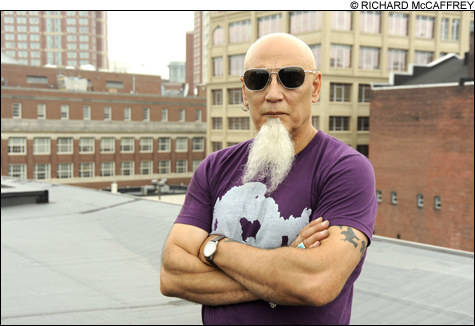
THE VISIONARY Crenca, on the roof at 95 Mathewson Street. |
The last time I saw Bert [Crenca] was probably a couple years ago, and that afternoon he had signed a $7 million mortgage on the Dreyfus Hotel. And I remember we used to have trouble getting $70 together. -- Ed Talbot
You might say it all began with a thumbs-down review of an art exhibit by Umberto Crenca. To Bert and his friends, it was just one more example of how they were excluded by the art establishment. They responded with a 1982 manifesto, outlining what became the founding principles of AS220 when it was launched as an alternative space (the AS) above the Providence Performing Arts Center at 220 Weybosset Street in 1985. It would be an uncensored, unjuried venue that aimed to be an integral part of society. AS220 moved to Richmond Street later that year, then to a building it bought and renovated at 115 Empire Street in 1992. Today AS220's reach includes the renovated Dreyfus building at 95 Mathewson Street, and the Mercantile Block next door on Washington Street, which is scheduled to open in October. It offers studios and apartments, galleries, performance spaces, a café and bar, a print shop, a photo lab, a tech lab, and youth workshops. It's all about providing creative opportunities.
As AS220 marks its 25th anniversary this month, it has touched the lives of thousands and thousands of people. Here are some of their stories.
BERT CRENCA, AS220 co-founder and artistic director: The show was at the Antonio Dattorro Studio Gallery on Steeple Street. It was a one-person exhibit of my work. It was all very political and it was all over the map. I had a painting of Lech Walesa, the Polish guy. I had stuff about Central America. I don't know, I had tons of shit. All kinds of political stuff. And it got panned by Channing Gray in
The Providence Journal. And then there was an op-ed piece by Steven Emma sort of criticizing Channing's review. He was saying that Channing's review was biased, and that we live in a world where political content is not revered any more in an artist's work, and look at all these different artists. It was very beautiful and well-written, and today I agree with Channing. It was all over the map, like Channing said, I don't think it really reached very deep. Then all these artists came by and we were getting drunk and we were chatting it up and I recommended that we start meeting at my house in North Providence at the time. A bunch of us started getting together talking about all the ills of the art world in Rhode Island and in Providence and decided to write a manifesto. We condemned everything, every institution associated with the arts, all grant agencies, museums, galleries, any kind of state or public funding. We said it doesn't have the right to discriminate against any artist. It's hierarchical, that it's classist, all that kind of shit. A manifesto, a real one. I think every weekly paper in the state printed it, or printed something about it. People are starting to respond to the article and contacting me and [manifesto co-author] Steven [Emma]. It was like, "Okay, what the hell would you guys do different?" We said we're going to put on an event called the Rhode Island Art Event, it was 1983, it's going to be open and unjuried to any Rhode Island artist in any medium who wants to do stuff. We hung stuff in Antonio Dattorro's gallery and did some performances at the Ashamu Studio [at Brown] and probably a few hundred people contributed and maybe a few hundred people came to the opening.
SUSAN CLAUSEN, AS220 co-founder and property manager: Scott Seaboldt was teaching a drawing class [at Ben Weiss Gallery]. And Bert [who was also teaching there] and he walked around downtown just looking up. It was them that spotted the space above PPAC [Providence Performing Arts Center].